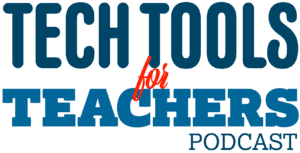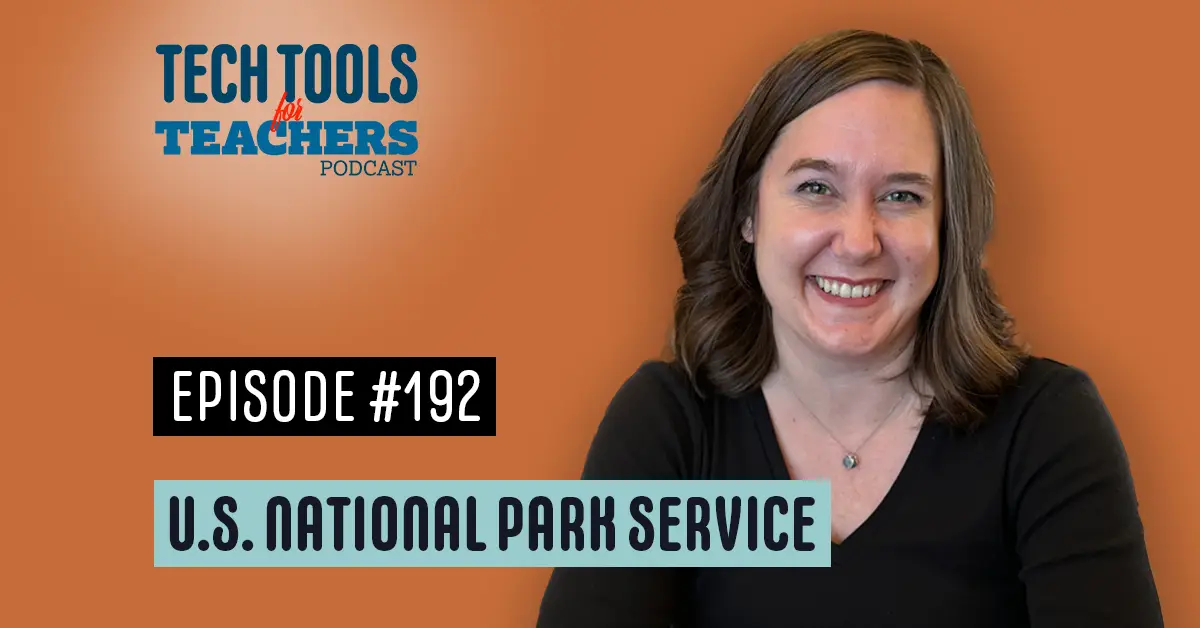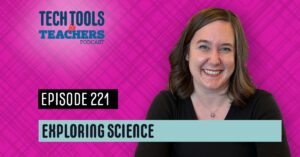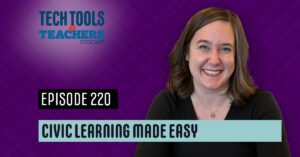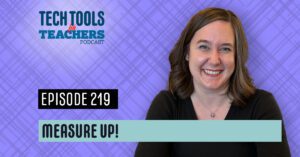[00:00:00] Shanna Martin: Thanks for listening to the Tech Tools for Teachers podcast, where each week we talk about a free piece or two of technology that you can use in your classroom. I’m your host, Shanna Martin. I’m a middle school teacher, technology, and instructional coach for my district.
[00:00:32] Fuzz Martin: And I’m her producer and husband, Fuzz Martin, and I love podcasting because I can just Park myself right in the studio and provide this service to thousands of people each week.
And by thousands, I mean hundreds. But you’ve had tens of thousands of listeners to the show over the 192 episodes.
[00:00:53] Shanna Martin: 192! Of this
[00:00:54] Fuzz Martin: show. Wonderful podcast
[00:00:57] Shanna Martin: that
[00:00:57] Fuzz Martin: we put out each and every week. Hello, Shanna.
[00:01:01] Shanna Martin: To support educators around the world.
[00:01:03] Fuzz Martin: With free tech tools that you can use in your classroom.
[00:01:07] Shanna Martin: So, I’m your host, Shanna Martin.
Yeah. So, fun fact, I alluded to this week’s episode. Last week.
[00:01:21] Fuzz Martin: Oh, Easter egg.
[00:01:23] Shanna Martin: Cause I used the site last week. You did. When you were. As an example. When, yeah,
[00:01:29] Fuzz Martin: in your in your quiz tools, your AI quiz tools. That’s right. You use this and you also used One of the, I was wearing a shirt.
[00:01:39] Shanna Martin: Yes, one of these things on it that the site talks about.
[00:01:44] Fuzz Martin: And that was completely coincidental.
[00:01:46] Shanna Martin: Whaaat?
[00:01:47] Fuzz Martin: Or maybe it caused you to look into these things, which caused you to find this tool.
[00:01:52] Shanna Martin: No, I use this tool all the time. So, if you haven’t guessed it. Yes. Suspense.
Bum, bum, bum. Yeah, really.
[00:02:02] Shanna Martin: We’re going to talk about the National Park Service today. All right.
Love it. So, let’s set this up. In the United States, there are many national parks.
[00:02:15] Fuzz Martin: Yes.
[00:02:16] Shanna Martin: And along with our national park system in the U. S., there are also, like national forests and then monuments, and they’re all run through our National Park Service. And they have a fantastic website that’s not just for, I mean, it’s for visitors, so anybody to visit any of the national parks.
Like, they have a beautifully designed, super helpful website. But it is also a fantastic resource for educators, twofold. There is tons of research and information, so if you have kids researching national parks, or if you have them researching wetlands or deserts, or if, even like water tables. Like, they have all kinds of resources.
Okay. So that’s my like number one, by the way. I’m like my top five list is I’m like just talking about it and set it up. So in my top five lists, there’s a ton of resources that are super helpful. Okay. This site is super engaging. There’s beautiful images and pictures and things like that to engage kids.
And also they can use them if they’re doing projects and things like that. So they have all these like cool images you can use. It’s really easy to navigate, like, I’m going to walk you through, like, you’re going to pick a state, and then within the state, it’ll give you the park, and I’m going to show you all, or talk about all the different things you can do with it.
Um, it can be used in so many different classrooms, so I use it in social studies class, our science teacher uses it, um, for our fourth graders who all get to have like free national park passes in the United States, like fourth graders get that for free. They can do their, like, background history, that kind of thing.
If you’re researching animals, you can do that. If you’re learning about different areas of the United States, you can use it. Like, there’s so many different ways. And then there’s all kinds of cool cultural pieces that are brought in. So, like, it’s Hispanic Heritage Month, the month of October, September, oh my goodness, what month am I in right now?
I am still in September. And so it’s September 15th through October 15th is when that’s celebrated. They have a whole section celebrating that. So there’s just so many cool resources and tools that are available through the website and it’s just a fantastic resource for educators. So I’m going to walk you through some cool highlights of it.
The site itself is nps. gov.
[00:04:39] Fuzz Martin: Easy enough.
[00:04:40] Shanna Martin: Yeah. National Park Service for the United States, nps. gov. And then there’s so many things, so you can choose, like, right away. They have Hispanic Heritage Month, they have a whole, like, celebration piece, automatic, like, cultural research, go. Then they have Find a Park or Explore America’s History by Topic, so you can choose a state.
or choose, Explore America’s History or Story, which goes, and that is where you can start with animals, bats, bears, um, biodiversity, birds, bison, dinosaurs, migratory species, wildflowers, like, no joke. But also, um, In America’s story part, they also have climate change, diseases, erosion, fire, fossils, geology.
So like, glaciers. I know our daughter’s class right now is researching Ice Age Trail and glaciers in fourth grade. We live in
[00:05:33] Fuzz Martin: the Kettle Moraine, so we learn a lot about the Kettle Moraine. Yes, the
[00:05:37] Shanna Martin: Kettles and the Moraines. Yes, glaciers. And the glaciers and the Niagara Escarpment. There are a whole lot of rock features here in Wisconsin. Canyons. So anyway, I can read this giant list, or you can go to the site and read this giant list yourself. And then it also, like, battlefields and canals and factories. Like, there’s so many things in America’s story. But actually I’m going to start with find a park and we’re going to pick a state and we’re going to go to Alaska.
[00:06:03] Fuzz Martin: Okay. North to Alaska. We’re going to
[00:06:05] Shanna Martin: Alaska. All right. So what’s cool about this is then automatically it gives you like drops you into a map that shows you all, uh, like here’s Alaska and then here’s like the different national pieces within Alaska.
Okay.
[00:06:20] Shanna Martin: It’s not just Denali, even though that’s what everybody knows is Denali.
Yeah.
[00:06:23] Shanna Martin: Then it talks about like, The Kenai, K E N A I, I can’t pronounce it, Fjords National Park. I’ve, like, one of our teachers went there, it’s beautiful and amazing and no one ever talks about it. There’s just so many, like, cool, they’re all listed there. Scroll down, or scroll out, it will take you out in the United States and then show you all of, like, where all the national park stuff is in the United States.
Scroll down, you can plan your trips. If you’re planning a vacation or a trip, cool, they’ve got that. But then, here you go, on the right hand side for every state, they have by the numbers. So, Alaska has 23 national parks, 1, 916, 088 visitors, Visit National Parks. It talks about the economic benefit. It talks about like community and conservation.
So it goes through all these numbers and all this information. Great for kids researching. Econ, math, like there’s so many different ways you can use all of these numbers that they set you up for. I am going to scroll down and go to Denali just because lots of people know Denali. And if you’ve ever watched the show, Molly of Denali, you’ll know.
And if you haven’t, PBS Kids, Molly of Denali. All right. I’m clicking on Denali. So then, this is the part that I use in my classroom with our science teacher, I’ve also used it and recommended it to various other grade levels, so, I mean, fifth grade uses this for research. Fourth grade, third grade, Denali.
You can scroll down, and it gives you like cool articles about the park, so you can learn about wildlife safety, things to do, like if you’re traveling there. However, if you’re scrolling and you’re at the top of it, it says plan your visit, so anybody vacationing, this is how I. So, yeah, that’s how we planned our trip to Rocky Mountain.
[00:08:13] Fuzz Martin: Yeah, which is the shirt that I had on. Oh no, no, no, I had on Mount Rushmore.
[00:08:17] Shanna Martin: That’s also how I planned our trip to Mount Rushmore. Yeah, that’s right. And so all the planning stuff is right there. I have a couple shirts. We’ve gone to a couple national parks. That’s like our new thing. But then under learn about the park, there’s a drop down tab and this is great for kids doing research projects because they have news releases.
So if you need like current event kind of stuff, it’s there. Photos, photo gallery for, I have kids, you know, putting together like photos and, and, and slideshows and stuff. History and culture, it goes through the park history and explains like the legend of Denali Collections. Nature, you can click on wildlife, it breaks it down by mammals, birds, amphibians, invertebrates in the park.
We use the geology section, so like, I can go Denali, nature, geology, and then from geology, click on glaciers, and then if you scroll through that, it gives you the background of the glaciers, how they were established, there’s a video, Explains life on glaciers, glaciers of Denali, gives you some more maps, and then gives you more sources of information that leads you to more research.
Like, it is so thorough when it comes to, like, if you’re teaching something or having kids research, it is so cool. That learned about the park section, they have science research, so if they have prey cycles, they have, like, water cycles, they have summaries, they have so many resources. For students and for teachers, which is so cool.
And then they also have, that’s not even like the education section, which is just, again, I’m just scrolling through where then they have like, professional development for teachers and distance learning options along with, if you want to plan a field trip to Denali, you can do that. And then they have a kids and youth section.
That would be cool, we should
[00:10:06] Fuzz Martin: do that. I’ll be a, I’ll be a chaperone.
[00:10:08] Shanna Martin: For that field trip. Um, and then at schools, like under kids and youth, they always have the junior ranger stuff. But then they also have like Denali Discovery Pack. And then they kind of set you up for a lesson. And kind of explain some like information, things like that.
And then like wilderness, there’s just. So many pieces of information. It’s crazy. They also talk about like climate in the area. So that’s like they get involved. They talk about like shrinking wetlands and, and volunteering all kinds of stuff. So that is all just, I picked a park and then all of the research and all of this cool information and these beautiful images come up, which is really helpful for kids and research and, nonfiction reading.
So like an ELA class, if you’re trying to Some nonfiction reading pieces, they’re thorough and they’re understandable, and again, they have great images and the kids are learning very relevant information. They keep it very up to date, which is awesome. So that’s all after just picking a park. So, nps.
gov, pick a park, and then you get all of this, like, world of cool information. And you can have kids focus, so sometimes, I have kids pick their own national park with their research, but you could focus within just one state if you want to, or if you want within a certain section of the United States, they can say anything in the Midwest or anything in the, you know, Southwest and they can pick region.
So, but wait, there’s more. I think I’m going to do this selling pitch. There’s so many things though that I use this site for. Not just kid research, but also, like, glacier work or different pieces of Wisconsin or rock formations, but also, if you go back to the homepage, so nps. gov, you click on Menu, which is in the upper right hand corner, and then you get another drop down of, like, all these things, so planning your visit, learning, but they have a section that’s for educators, And you click on the education section and then you type in.
So you can pick your topic or you can choose your subject, language, arts, math, science, social studies, or, and then you can choose your grade level. And then you can choose which common core standards you want to align with. Yeah, magic.
[00:12:20] Fuzz Martin: When it’s got all of them.
[00:12:22] Shanna Martin: Yeah. So I’m just going to choose, and I’m not going to get too specific because I want to be able to share information.
They also have college and undergraduate level and college graduate level resources, along with adult education, just so you’re all aware. I’m going to choose upper elementary. That one’s easy. I’m going to choose high school, ninth through 12th grade, because the elementary things are very easy to find when you pull up animals and things like that.
Sure.
[00:12:49] Shanna Martin: And a lot of the National Park stuff, they have a whole, like, fourth grade section since it’s a big deal. So I just pulled up Educator Resources, 9 12, and then I can choose, like, then you get this whole section if I really wanted to break it down. Do I want a science lab? Do I want a guest speaker? Do I want, distance learning options?
Do I want a specific location like New Orleans or the Grand Canyon or Shenandoah National Park, or I can pick my subject. So you’re aware there are in the 9 12 section, 191 lessons for high school associates, 97 lessons for science, 84 lessons for literacy, and 37 lessons for math. So we’re not lacking in resources for educators.
You can break it down by standard, but you have like. A whole lesson on immigration. It gives you the lesson plan. It gives you the breakdown. They have one on climate and science, focus and data and tools. Climate science, earth as a system. They have, Battle at Stones River, a contrast of leadership styles.
So I’m just going to pick one. What do I want to do? Let’s talk about, I don’t know, there’s so many choices. Let’s go with leafy thermometers and rain gauges. It’s a six part activity to investigate climate and climate change using fossil leaves. from Wyoming.
Okay.
[00:14:14] Shanna Martin: And you scroll through the lesson plan.
It gives you, it tells you like materials, photographs of this provided, copies of the steps provided, charts provided. They have all of the climate analysis worksheet, climate change. All of this is provided. They want you to collect leaves from your area. You need rulers, calculators, scrap paper for leaf labels.
Paperclips and some index cards. It gives you down the entire breakdown of the lesson. Part one, part two, part three through five gives you the assessment, the extensions, and then you scroll down and all your materials are there for you. So it gives you a download for the instructions, a download for the leaf demos.
It gives you. All the fossil leaf sets. So it really, it gives you all the resources you need for that lesson, except for like rulers and leaves from your backyard. And that’s for a high school. Like it’s crazy how much they put into each of these lessons to support educators. And then they also have lesson plans to connect.
So if you really liked that lesson and you want to continue on it, it totally applies to your science class. There’s then like other choices, other choice lesson plans that fit with that that you can continue on with or build on that lessons. It’s crazy how many resources they have built up. There’s one on water tables and they give you a whole actual PowerPoint for the students, like, explaining how that works.
So there’s all kinds of resources. It’s not just, like, worksheets and stuff, but it’s also video resources and educational, like, discussion resources and all kinds of stuff. Which is insane, because it’s all here on nps. gov.
[00:15:58] Fuzz Martin: I mean, it’s cool that they’ve put so many, put so much resource behind it it’s really well thought out and, and set up for teachers.
And easy to find. Like,
[00:16:07] Shanna Martin: that’s my thing always, like, I love a good resource, but I gotta be able to find it quickly. Yeah. And so, like, I literally just typed in Lincoln to see what would happen. Cool. Homestead Act. Lesson plan.
[00:16:18] Fuzz Martin: I was just going to say, we were just talking about the Homestead Act the other day, and I pulled up a whole thing, like, it has the documents on the Homestead Act and how that came to be.
And, uh, very cool.
[00:16:28] Shanna Martin: Yeah. They have a whole lesson called Math at Mount Rushmore for grades 9, 10, 11, and 12. And they talk about calculating and estimating the weight of Mount Rushmore. And figuring out the volume and the cross sections of the model, and they have a whole lesson plan based on it. Like, there’s so many cool things that they just To build on lessons you’re already teaching, and just these cool resources that they have.
They have Spaceflight Explorer for Junior Rangers. They have a whole thing on space, too. Like, there’s just so many resources. So, I really wanted to highlight this one this week, not just because I dropped it in last week, as I mentioned, because I use it all the time. When I thought about it, I’m like, I’ve never really talked about this site, and this is one of my go to’s for extra support for my students, or if they’re really engaged in a topic, like pulling up more information, and then I do do a research project on national parks, so there’s just so many times I use this site that I thought, wow, I’ve never talked about it, and I really need to share this with everybody, because it is so cool, and there’s so many cool things.
And of course, you can plan a vacation, too, if you want to, because that’s all there for you, as well. But yeah, go explore. It’s nps. gov. And there’s so many ways you could build these resources into your classroom. And even if it’s just pulling up Like, pick your national park and pull up that photo gallery.
What a cool way to get kids to journal topic or imagine you’re here. How, like, how would you feel if you were sitting in this, like, lake? Or if you saw this, what do you think you’d be hearing or listening or smelling? You know, you could do sensory writing. There’s just, I don’t know. There’s so many ways to use this site that I think you, you’re, you need to check it out and just think about how could you use that in your classroom.
[00:18:09] Fuzz Martin: Yeah. So many ways.
[00:18:12] Shanna Martin: So there you go.
[00:18:13] Fuzz Martin: Even if you don’t live in the U. S.
[00:18:15] Shanna Martin: Yeah, that’s the thing too, is like, you can explore these places, and, you don’t have to live here to see them, just to, like, learn about how cool they are, and all the different things that, like, Bio, you know, like all its stuff applies all
[00:18:29] Fuzz Martin: over the place.
But Parks Canada’s website’s nice too.
[00:18:32] Shanna Martin: Yes.
[00:18:32] Fuzz Martin: Doesn’t have as many resources , but it’s nice
[00:18:34] Shanna Martin: too. There’s, and there is some everywhere , I just, I it’s very cool. And, but,
[00:18:38] Fuzz Martin: Yeah, nPS. gov is, uh, just chock full of resources.
[00:18:44] Shanna Martin: Yeah. And helpful things for educators.
[00:18:47] Fuzz Martin: Good work.
[00:18:48] Shanna Martin: Cool. Well, thanks for tuning in.
This has been the Tech Tools for Teachers podcast. If you ever have any questions, you can find me on the app formerly known as Twitter, as smartinwi or on Threads, or Insta, or if you want to get more information on the links to the technology discussed in this best episode, you can visit smartinwi. com. If you’d like to support the show, please consider buying me a coffee or two.
Visit buymeacoffee. com slash smartinwi or visit smartinwi. com and click on that cute little purple coffee cup. Your donations help keep this show going. New episodes each week. Thanks for listening. Go educate and innovate.
[00:19:24] Fuzz Martin: The ideas and opinions expressed on this podcast and the smartinwi.com website are those of the author, Shanna Martin, and not of her employer.
Prior to using any of the technologies discussed on this podcast, please consult with your employer regulations. This podcast offers no guarantee that these tools will work for you as described, but we hope they do, and we’ll talk to you next time right here on the Tech Tools For Teachers Podcast.
